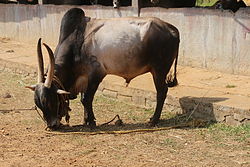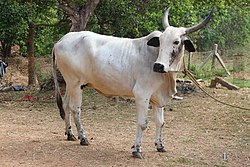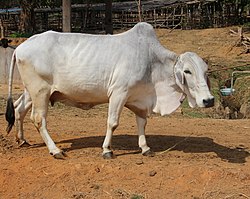| Local name | Other names | Notes | Image |
|---|
| Alambadi [1] [4] | | Tamil Nadu | |
| Amrit Mahal [1] [4] | Amritmahal | Karnataka [2] |  |
| Bachaur [1] [4] | | Bihar [2] | |
| Badri [2] | | Uttarakhand [2] | |
| Bargur [1] [4] | | Tamil Nadu [2] |  |
| Belahi [2] | | Haryana, Chandigarh [2] | |
| Bengali [1] | | | |
| Binjharpuri [1] [4] | | Orissa [2] | |
| Brownsind [1] | | Allahabad; composite of Red Sindhi and Brown Swiss | |
| Cutchi [1] | Kachhi | Cutch, north-western Gujarat | |
| Dangi [1] [4] | | Maharashtra, Madhya Pradesh [2] |  |
| Deoni [1] | | Maharashtra, Karnataka [2] |  |
| Devarakota [1] | | Tamil Nadu, regional variant of Ongole | |
| Devni [1] | | Osmanabad, Maharashtra | |
| Frieswal [1] | | composite breed | |
| Gangatiri [1] [4] | Shahabadi | Uttar Pradesh, Bihar [2] |  |
| Gaolao [1] [4] | | Maharashtra, Madhya Pradesh [2] |  |
| Ghumusari [1] [4] | Goomsur; [3] : 190 Ghumsuri [4] | Orissa [2] | |
| Gir [1] [4] | | Gujarat [2] |  |
| Goomsur [1] | see Ghumusari | | |
| Gujamavu [1] | | variant of Hallikar [3] : 193 | |
| Hallikar [1] [4] | | Karnataka [2] |  |
| Hariana [1] [4] | | Haryana, Uttar Pradesh, Rajasthan [2] |  |
| Hissar [1] | - Hansi-hissar
- Hissar-hansi
- Hissar-hariana
- Hansi [1]
| southern Punjab | |
| Jellicut [1] | see Pulikulam | | |
| Jersind [1] | | Allahabad; composite of Red Sindhi and Jersey | |
| Kangayam [1] [4] | | Tamil Nadu [2] |  |
| Kankrej [1] [4] | | Gujarat, Rajasthan [2] |  |
| Kappiliyan [1] | see Jellicut | | |
| Karan Fries [1] | | composite of Tharparkar and Friesian | |
| Karan Swiss [1] | | composite of Sahiwal and Brown Swiss | |
| Kasaragod [3] : 322 | | Kerala [3] |  |
| Kenkatha [1] [4] | | Uttar Pradesh, Madhya Pradesh [2] |  |
| Khamala [1] | | Betul, southern Madhya Pradesh | |
| Khariar [1] | | Orissa [2] | |
| Khasi [1] | Assam Hill; Assam Plain | Assam, north-eastern states; variant of Bengali | |
| Kherigarh [1] [4] | | Uttar Pradesh [2] |  |
| Khillari [1] [4] | | Maharashtra, Karnataka [2] |  |
| Kosali [2] | | Chhattisgarh [2] | |
| Krishnagiri [1] | | Tamil Nadu | |
| Krishna Valley [1] [4] | Kistna Valley | Karnataka [2] |  |
| Kumauni [1] [4] | | northern Uttar Pradesh | |
| Ladakhi [1] [4] | | Kashmir | |
| Lakhimi [1] [2] | | Assam | |
| Malnad Gidda [1] [4] | | Karnataka [2] |  |
| Malvi [1] [4] | | Madhya Pradesh [2] |  |
| Mampati [1] [4] | | Madhya Pradesh | |
| Manapari [1] [4] | | Tamil Nadu | |
| Mewati [1] [4] | | Rajasthan, Haryana, Uttar Pradesh [2] | |
| Mhaswad [1] | | variant of Khillari | |
| Motu [1] [4] | Deshi | Orissa, Chhattisgarh, Andhra Pradesh [2] | |
| Nagori [1] [4] | | Rajasthan [2] |  |
| Nakali [1] | | variant of Khillari | |
| Nimari [1] [4] | Khargoni; Khurgoni; Khargaon | Madhya Pradesh [2] |  |
| Ongole [1] [4] | | Andhra Pradesh [2] |  |
| Ponwar [1] [4] | | Uttar Pradesh [2] |  |
| Pulikulam [1] [4] | Jellicut; Kilakattu; Kilkad; Kilakad | Tamil Nadu [2] | |
| Punganur [1] [4] | | Andhra Pradesh [2] | |
| Purnea [1] | Red Purnea [4] | north-eastern Bihar | |
| Ramgarhi [1] | | east Mandla, Madhya Pradesh | |
| Rathi [1] [4] | | eastern Rajasthan [2] |  |
| Red Kandhari [1] [4] | Lakhalbunda | Maharashtra [2] |  |
| Red Sindhi [1] [2] [4] | Malir; Sindhi; Red Karachi | |  |
| Sahiwal [1] [4] | | Punjab, Rajasthan [2] |  |
| Sanchori [1] | Marwari | Jodhpur, Rajasthan; variant of Kankrej | |
| Shahabadi [1] [4] | see Gangatiri | | |
| Siri [1] [4] | Trahbum | Sikkim, West Bengal [2] | |
| Son Valley [1] | | Madhya Pradesh | |
| Sunandini [1] | | Kerala; composite of local zebuine stock and Brown Swiss | |
| Tarai [1] [4] | | | |
| Taylor [1] | | Patna, Bihar; composite of local zebuine stock with Shorthorn and Channel Island stock | |
| Tharparkar [1] [4] | Grey Sindhi; White Sindhi; Thari | Rajasthan [2] |  |
| Thillari [1] | Tapti; Tapi | | |
| Tho Tho [1] [3] : 314 [4] | | Nagaland | |
| Umblachery [1] [4] | Mottai Madu; Southern; Tanjore; Therkuthi Madu | Tamil Nadu [2] |  |
| Vechur [1] [4] | | Kerala [2] |  |
|




























